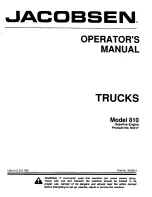
STARTING AND DRIVING
ALLISON TRANSMISSION
transmission fluid expansion when the
temperature increases. The lower band,
referred to as COLD CHECK, is used
when the transmission fluid is below
operating temperature. The upper band,
referred to as HOT CHECK , is used
when the transmission fluid is at normal
operating temperature. The OEM may
refer to these as COLD FULL/COLD
ADD (COLD CHECK) and HOT
FULL/HOT ADD (HOT CHECK).
1
Allison Dipstick, 11 Liter Engine
Cold Check
WARNING
If you leave the vehicle and the engine is
running, the vehicle can move
unexpectedly and you or others could be
injured. If you must leave the engine
running, do not leave the vehicle until you
have completed all of the following
procedures:
1
Put the transmission in N (Neutral).
2
Be sure the engine is at low idle (500–
800 rpm).
3
Apply the parking brakes and
emergency brake and make sure they
are properly engaged.
4
Chock the wheels and take any other
steps necessary to keep the vehicle
from moving.
CAUTION
DO NOT start the engine until the
presence of sufficient transmission fluid
has been confirmed. Remove the
transmission fluid dipstick and be sure the
static fluid level is near the HOT FULL
mark.
CAUTION
The fluid level rises as fluid temperature
rises. DO NOT fill the transmission above
the COLD CHECK band if the
transmission fluid is below normal
operating temperatures. During operation,
an overfull transmission can become
overheated, leading to transmission
damage.
NOTE
With engine off, the fluid level should
reach the hot run band or higher on the
dipstick even at cold ambient
temperatures. The cold check band is
calibrated on the stick for the fluid level
attained while the transmission is running
and in N (Neutral). Do not move the
vehicle until the fluid level reaches the
cold full mark with engine running and
transmission in N (Neutral).
NOTE
The correct fluid level cannot be
determined unless the transmission is in a
level position.
The COLD CHECK band verifies the
transmission has adequate fluid for
startup and operation until it can be
checked at the operating (hot)
temperature. Only use this check to
confirm adequate fluid level for a cold
startup and not to set fluid levels for
163
X Publication_PC28
Summary of Contents for M359
Page 3: ...FAX 61 7 3718 3391...
Page 9: ......
Page 10: ......
Page 11: ...INTRODUCTION...
Page 24: ...INTRODUCTION GENERAL SAFETY INFORMATION 1 Airbrake System Label 14 X Publication_PC28...
Page 51: ...41 X Publication_PC28...
Page 52: ......
Page 53: ...DRIVING TIPS...
Page 70: ...DRIVING TIPS DRIVING IN A DUSTY AND SMOKY ENVIRONMENT Use recirculation 60 X Publication_PC28...
Page 72: ...DRIVING TIPS PARKING Use the Parking Brake Avoid use of Idling Speed 62 X Publication_PC28...
Page 78: ......
Page 79: ...SAFETY...
Page 86: ......
Page 87: ...LOCKS AND ALARM...
Page 90: ......
Page 91: ...DRIVING ENVIRONMENT...
Page 145: ...135 X Publication_PC28...
Page 146: ......
Page 147: ...STARTING AND DRIVING...
Page 195: ...185 X Publication_PC28...
Page 196: ......
Page 197: ...INFOTAINMENT...
Page 205: ...195 X Publication_PC28...
Page 206: ......
Page 207: ...EMISSION SOLUTION AND CONTROL...
Page 227: ...217 X Publication_PC28...
Page 228: ......
Page 229: ...MAINTENANCE LUBRICATION AND SERVICE...
Page 273: ...MAINTENANCE LUBRICATION AND SERVICE ELECTRICAL SYSTEM Fuse Panel Layout 263 X Publication_PC28...
Page 305: ...MAINTENANCE LUBRICATION AND SERVICE LUBRICATION 295 X Publication_PC28...
Page 317: ...307 X Publication_PC28...
Page 318: ......
Page 319: ...EMERGENCY ACTION...
Page 332: ...CID0123456 CID0123456...







































